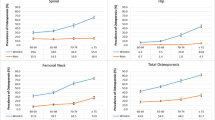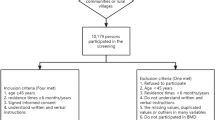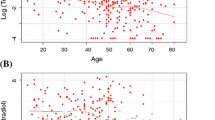Conclusion
Osteoporosis is common in Chinese men and women living in Taiwan. Although the incidence of hip fracture seems to be lower in this region, the prevalence of vertebral fractures is high and similar in Taiwan to the rates in northern Europe or North America. Taiwanese have relatively low calcium intake, but the vitamin D stores seems to be generally adequate. In this region, elevated bone turnover markers are shown to be associated with lower BMD values in men and postmenopausal women. Vitamin D receptor gene and estrogen receptor gene polymorphisms were not found to be related to BMD or bone marker values. Because a larger proportion of population will be affected by osteoporosis as the population ages, Taiwanese need some sensitive and specific means to guide the effective control program for osteoporotic fractures. Although the mechanism of rapid turnover in certain individuals is not yet clear, bone markers and BMD may be useful to identify those who are at higher risk and need special attention.
Similar content being viewed by others
References
Cooper C, O’Neil T, Silman A. The epidemiology of vertebral fractures. Bone 1993;14:S 89–97.
Tsai KS, Twu SJ, Chieng PU, et al. The Geriatric Study Group, ROC. Prevalence of vertebral fractures in Chinese men and women in urban Taiwanese communities. Calcif Tissue Int 1996;59:249–53.
Melton LJ III. Hip fractures: a worldwide problem today and tomorrow. Bone 1993;14:S l-8.
Tsai YJ, Lin HS, Chou LP, et al. A pilot study on health sector priority review — by retrospective study on the elderly hip fracture in Taiwan, (monograph). Taichung: Taiwan provincial Institute of Family Planning, 1997.
Tsai KS, Huang KH, Chieng PU, et al. Bone mineral density of normal Chinese women in Taiwan. Calcif Tissue Int 1991; 48:161–6.
Tsai KS, Pan WH, Hsu SHJ, et al. Sexual differences in bone markers and bone mineral density of normal Chinese. Calcif Tissue Int 1996;59:454–60.
Sugimoto T, Tsutsumi M, Fujii Y, et al. Comparison of bone mineral content among Japanese, Korean and Taiwanese assessed by dual photon absorptiometry. J Bone Miner Res 1992;7:153–8.
Russell-Aulet M, Wong J, Thornton JC, et al. Bone mineral density and mass in a cross-sectional study of white and Asian women. J Bone Miner Res 1993;8:575–81.
Tsai KS, Cheng WC, Sanchez TV, et al. Bone densitometry of proximal femur in Chinese: sexual differences in bone mass and bone areas. Bone 1997;20: (in press).
Hui SL, Slemenda CW, Johnston CC Jr. Age and bone mass as predictors of fracture in a prospective study. J Clin Invest 1988;81:1804–9.
Liel Y, Edwards J, Shary J, et al. The effect of race and body habitus on bone mineral density of the radius, hip and spine in premenopausal women. J Clin Endocrinol Metab 1988; 66:1247–50.
Christiansen C, Riis BJ, Rodbro P. Prediction of rapid bone loss in postmenopausal women. Lancet I: 1987; 1105–10.
Garnero P, Sorney-Rendu E, Chapuy M-C, et al. Increased bone turnover in late postmenopausal women is a major determinant of osteoporosis. J Bone Miner Res 1996;11:337–49.
Morrison NA, Qi JC, Tokita A, et al. Prediction of bone density from vitamin D receptor alleles. Nature 1994;367:284–7.
Eisman JA. Vitamin D receptor gene alleles and osteoporosis: an affirmative view. J Bone Miner Res 1995;10:1289–93.
Peacock M. Vitamin D receptor gene alleles and osteoporosis: a contrasting view. J Bone Miner Res 1995;10:1294–7.
Tsai KS, Hsu SHJ, Cheng WC, et al. Bone mineral density and bone markers in relation to vitamin D receptor gene Polymorphisms in Chinese men and women. Bone 1996;19:5:513–8.
Kobayashi S, Inoue S, Hosoi T, et al. Association of bone mineral density with polymorphism of the estrogen receptor gene. J Bone Miner Res 1996;11:3:306–11.
Villareal DT, Civitelli R, Chines A, et al. Subclinical vitamin D deficiency in postmenopausal women with low vertebral bone mass. J Clin Endocrinol Metab 1991;91:628–34.
Tsai KS, Hsu SHJ, Cheng JP, {eaet al.} Vitamin D stores of urban women in Taipei: effect on bone density and bone turnover, and seasonal variation. Bone 1997;20:(in press).
Huang PC, Yu SL, Lee SM, et al. Dietary survey in Taiwan area, 1980–81. J Chinese Nutrition Soc 1983;8:1–20.
Cheng CP: The relationship between bone density and dietary factors, [dissertation]. Graduate Institute of Nutritional Sciences, Fu-Jen Catholic University, Taipei, Taiwan, ROC, 1994:77–8.
Lan CF, Lin IF, Wang SJ: Fluoride in drinking water and the bone mineral density of women in Taiwan. Int J Epidemiology 1995;24:1182–7.
Author information
Authors and Affiliations
Rights and permissions
About this article
Cite this article
Tsai, K.S., Tai, T.Y. Epidemiology of osteoporosis in Taiwan. Osteoporos Int 7 (Suppl 3), 96–98 (1997). https://doi.org/10.1007/BF03194352
Issue Date:
DOI: https://doi.org/10.1007/BF03194352




